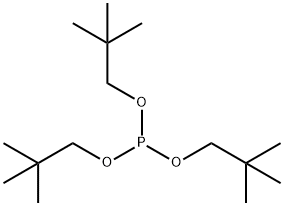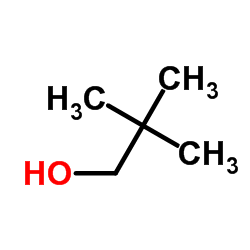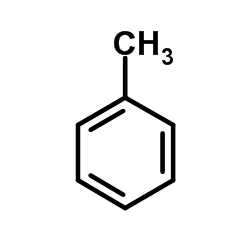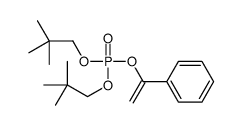亚磷酸三新戊酯 ,Tri-neo-pentylphosphite ,≥90%
产品编号:Bellancom-B53528| CAS NO:14540-52-4| 分子式:[(CH3)3CCH2O]3P| 分子量:292.40
本网站销售的所有产品仅用于工业应用或者科学研究等非医疗目的,不可用于人类或动物的临床诊断或者治疗,非药用,非食用,
| 英文名称 | Tri-neo-pentylphosphite |
|---|---|
| CAS编号 | 14540-52-4 |
| 产品熔点 | 55-57ºC |
| 产品沸点 | 80ºC 0,15mm |
| 产品闪点 | 164.4ºC |
| 精确质量 | 292.21700 |
| PSA | 41.28000 |
| LogP | 5.40140 |
| 外观性状 | crystal | white |
| 蒸气压 | 0.00196mmHg at 25°C |
相关文档
化学品安全说明书(MSDS)
下载MSDS质检证书(COA)
相关产品
| 风险声明 (欧洲) | 36/37/38 |
|---|---|
| 安全声明 (欧洲) | 26-36/37/39 |
| 海关编码 | 2920901900 |
|
Section 1: Product Identification Chemical Name:Tri-neo-pentylphosphite, min.90% CAS Registry Number:14540-52-4 Formula:[(CH3)3CCH2O]3P EINECS Number:none Chemical Family:organophosphorus compound Synonym:Trineopentoxyphosphine, phosphorous acid, tri-neo-pentyl ester, phosphorus trineopentoxide.
Section 2: Composition and Information on Ingredients IngredientCAS NumberPercentACGIH (TWA)OSHA (PEL) Title Compound14540-52-4100%no datano data Section 3: Hazards Identification Emergency Overview:Solid may be irritating to skin, eyes and respiratory tract. May be harmful if swallowed. Primary Routes of Exposure:Ingestion, inhalation Eye Contact:May cause slight to mild irritation of the eyes Skin Contact:May cause slight to mild irritation of the skin. Inhalation:Dust may be irritating to the nose, mucous membranes and respiratory tract. No specific information is available on the physiological effects of ingestion. May cause vomiting and diarrhea. Ingestion: Acute Health Affects:May be irritating to skin, eyes and respiratory tract. Chronic Health Affects:No information available on long-term chronic effects. NTP:No IARC:No OSHA:No SECTION 4: First Aid Measures Immediately flush the eyes with copious amounts of water for at least 10-15 minutes. A victim may need Eye Exposure: assistance in keeping their eye lids open. Get immediate medical attention. Wash the affected area with water. Remove contaminated clothes if necessary. Seek medical assistance if Skin Exposure: irritation persists. Remove the victim to fresh air. Closely monitor the victim for signs of respiratory problems, such as difficulty Inhalation: in breathing, coughing, wheezing, or pain. In such cases seek immediate medical assistance. Seek medical attention immediately. Keep the victim calm. Give the victim water (only if conscious). Induce Ingestion: vomiting only if directed by medical personnel. SECTION 5: Fire Fighting Measures Flash Point:not applicable Autoignition Temperature:no data Explosion Limits:no data Extinguishing Medium:dry chemical, carbon dioxide, or foam. Fire fighters should be equipped with a NIOSH approved positive pressure self-contained breathing apparatus Special Fire Fighting Procedures: and full protective clothing. Hazardous Combustion andIf involved in a fire this material may emit toxic organic fumes, carbon monoxide, and phosphorous oxides. Decomposion Products: Unusual Fire or Explosion Hazards: No unusual fire or explosion hazards. SECTION 6: Accidental Release Measures Small spills can be mixed with vermiculite, sodium carbonate or other suitable non combustible adsorbent and Spill and Leak Procedures: swept up. SECTION 7: Handling and Storage Store in a cool, dry, well-ventilated area away from heat and direct sunlight. This product may react slowly with Handling and Storage: air and moisture. Transfer material under an inert atmosphere of dry nitrogen or argon. SECTION 8: Exposure Controls and Personal Protection Eye Protection:Always wear approved safety glasses when handling a chemical substance in the laboratory. Skin Protection:Wear protective clothing and gloves. Consult with glove manufacturer to determine the proper type of glove. Ventilation:Material may form a fine dust. Work with this product in a well-ventilated area, preferably a fume hood. If ventilation is not available a respirator should be worn. The use of respirators requires a Respirator Respirator: Protection Program to be in compliance with 29 CFR 1910.134 Ventilation:Material may form a fine dust. Work with this product in a well-ventilated area, preferably a fume hood. Additional Protection:No additional protection required. SECTION 9: Physical and Chemical Properties Color and Form:white xtl. Molecular Weight:292.4 Melting Point:55-57° Boiling Point:80°C /0.15 mm Vapor Pressure:no data Specific Gravity:no data Odor:unpleasant odor Solubility in Water:insoluble SECTION 10: Stability and Reactivity Stability:air sensitive Hazardous Polymerization:no hazardous polymerization Conditions to Avoid:prolonged contact with air or moisture, especially at elevated temperature. Incompatibility:oxygen, oxidizing agents, sulfur, and halogens Decomposition Products:carbon dioxide, carbon monoxide, organic fumes, dineopentylphosphonate, and phosphorus pentoxide. SECTION 11: Toxicological Information RTECS Data:No information available in the RTECS files. Carcinogenic Effects:No data available Mutagenic Effects:No data available Tetratogenic Effects:No data available SECTION 12: Ecological Information Ecological Information:No information available SECTION 13: Disposal Considerations Disposal:Dispose of according to federal, state, and local regulations. SECTION 14: Transportation Shipping Name (CFR):Non-hazardous Hazard Class (CFR):NA Additional Hazard Class (CFR):NA Packaging Group (CFR):NA UN ID Number (CFR):NA Shipping Name (IATA):Non-hazardous Hazard Class (IATA):NA Additional Hazard Class (IATA):NA Packaging Group (IATA):NA UN ID Number (IATA):NA SECTION 15: Regulatory Information TSCA:Not listed in the TSCA inventory. SARA (Title 313):Title compound not listed. Second Ingredient:none SECTION 16 - ADDITIONAL INFORMATION N/A |
| 上游产品 2 | |
|---|---|
| 下游产品 2 | |












![2-[bis(2,2-dimethylpropoxy)phosphoryl]-1-phenylethanone结构式](/20230522/89499-72-9.png)





 浙公网安备 33010802013016号
浙公网安备 33010802013016号